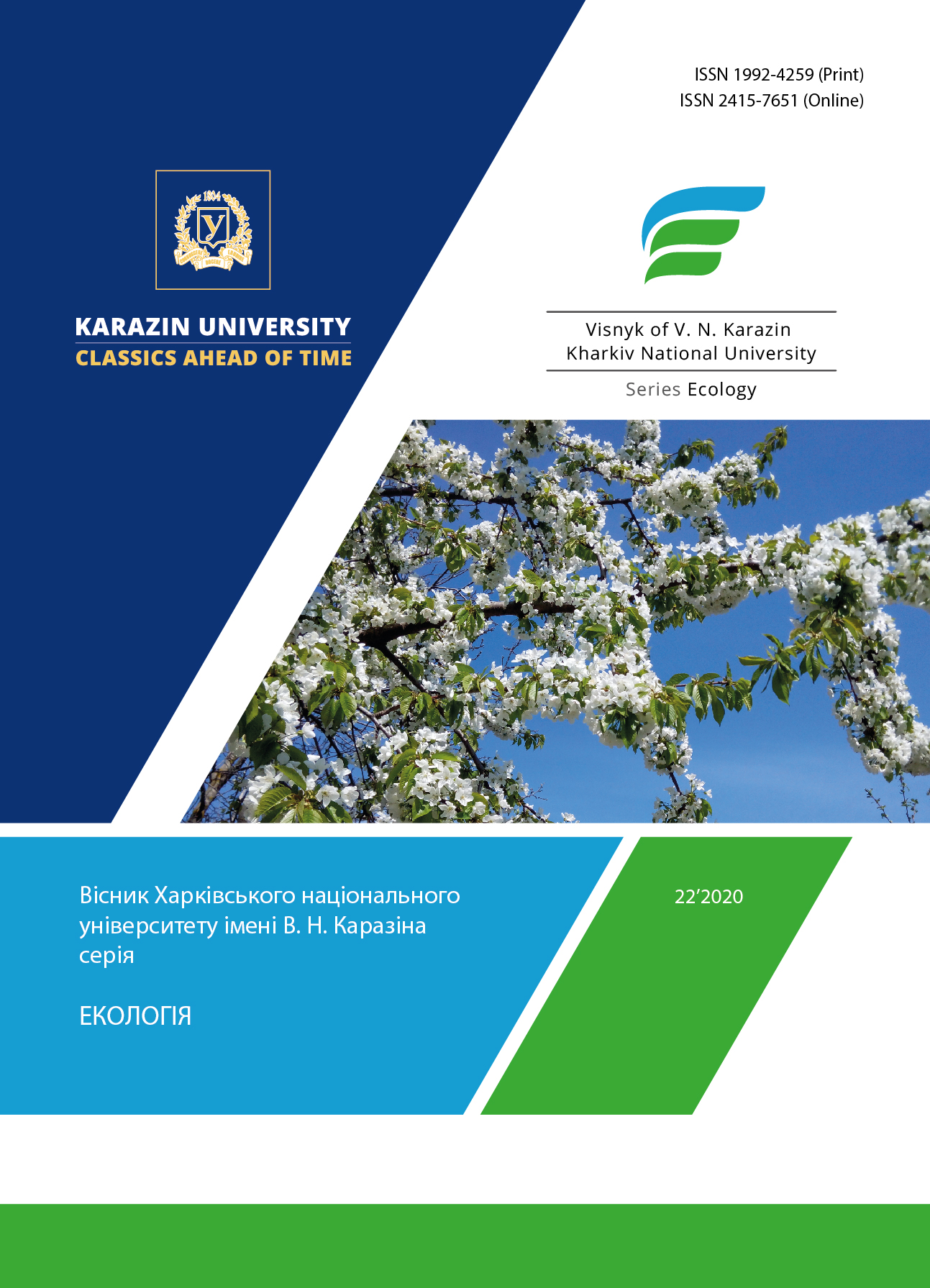State o Phytocenosis in Beremytske Nature Park
Abstract
Purpose. Botanical analysis of existing vegetation in the territory of the “Beremitske” Nature Park for further zoning and selection of individual territories where reproduction of the original state of the phytocenosis is planned.
Methods. Field research methods for the analysis of the taxonomic composition of the flora in the park, cartographic methods for zoning the area and historical analysis of the land use of the former landowners.
Results. The conducted flora monitoring showed that in the studied territories the adventitious and synanthropic species predominated, in particular in the meadow-steppe areas the invasive and synanthropic vegetation was represented by Ambrosia artemisiifolia, Asclepias syriaca, Amaranthus retroflexus, Arctium lappa, Sonchus arvensis, Tanacetum vulgare, Medicago lupulina, Verbascum phlomoides, Urtica dioica. Among the wood forms Betula pendula, Robinia pseudoacacia, Picea abies, Pinus sylvestris, Pinus sylvestris Populus nigra, Alnus glutinosa, Carpinus betulus predominated. Among the rare plants we identified the accumulation of Iris
sibirica in some meadow-swamp areas. The scheme of the park has been developed and the starting points at which flora reproduction is planned to be identified.
Conclusions. The species composition of the phytocenosis showed the predominance of invasive vegetation species in some areas of the park. The growth sites of the endangered species of Iris sibirica have been found, and in the future will allow to design new ecological trails in the park and to reintroduce it to other suitable sites. The data obtained will allow to develop a scheme of restoration of the original floral biodiversity in the park, taking into account the identified features.
Downloads
References
Didukh, Y. (2009). Red Book of Ukraine. Plant life. Kyiv: Global Consulting (in Ukrainian).
Andrienko, T. (1997). Rare and useful flora plants of Chernihiv region in nature and culture. Kyiv: Phytosociocenter (in Ukrainian).
Andrienko, T. L., Lukash, O. V., Pryadko, O. I. et all (2007). Rare species of vascular plants of Chernihiv region and their presence in the nature reserves of the region. Conservation business in Ukraine, 13(1-2), 33-38 (in Ukrainian).
Department of Ecology and Natural Resources of Chernihiv Regional Administration. Report on the state of the PFP in the Chernihiv region in 2019. Retrieved from http://eco.cg.gov.ua/index.php?id=16893&tp=1&pg= (in Ukrainian).
Hoogendoorn, G., Meintjes, D., Kelsom, C. & Fitchett, J. (2019). Tourism as an incentive for rewilding: the conversion from cattle to game farms in Limpopo province, South Africa. Journal of Ecotourism, 18(4), 309-315. https://doi.org/10.1080/14724049.2018.1502297
Hall, Michael C. (2019). Tourism and rewilding: an introduction – definition, issues and review. Journal of Ecotourism, 18(4), 297-308. https://doi.org/10.1080/14724049.2019.1689988
Lorimer, C., Sandom, P., Jepson, C. & Doughty Kirby, M. Rewilding: Science, practice, and politics (2015). J. Annual Review of Environment and Resources, (40), 39-62. https://doi.org/10.1146/annurev-environ-102014-021406
Datko, L.V. & Maistrenko, M. I. (2012). Ecological and economic aspects of sustainable land use for soil fertility reproduction. Soil fertility protection, (8), 24-39 (in Ukrainian).
Konischuk, V. V, Konishchuk, M. O, Bulgakov, V. P, Bobryk, I. V., et all (2015). Soil fertility and ways of preserving their ecological stability in Chernihiv Polissya. Agro-ecological journal, (1), 76-83 (in Ukrainian).
Yashchenko, P. & Nadorozhnyak, O. (2003). Silvation as a process and factors of renaturalization of natural ecosystems in Western Polesie. Forest Research in Ukraine, Scientific Bulletin, 3 (13), 171-175 (in Ukrainian).
Levykin, S., Chibilev, A., Kazachkov, G., Yakovlev, I., Chibileva, V. & Grudinin, D. (2017). The concept of territorial protection of the Novosibirsk archipelago based on the development of ideas of rebuilding and Pleistocene park. Bulletin of the Orenburg Scientific Center of the Ural Branch of the Russian Academy of Sciences, (4). Retrieved from http://elmag.uran.ru:9673/magazine/Numbers/2017-4/Articles/LSV-2017-4.pdf (in Russian).
Donlan, C. J. et al. (2006). «Pleistocene Rewilding»: an optimistic agenda for twenty-first century conservation». The American Naturalist, (1), 22.
Svenning, J. C. (2002). A review of natural vegetation openness in north-western Europe. Biological Conservation, (104), 133-148.
Rubenstein, D., Rubenstein, D., Sherman, W. & Gavin, T. (2006). Pleistocene Park: Does re-wilding North America represent sound conservation for the 21st century? Biological Conservation, 132(2), 232-238.
Galetti, M. (2004). Parks of the Pleistocene: Recreating the cerrado and the Pantanal with megafauna. Natureza e Conservação, 2 (1), 93–100.
Pellis, Arjaan (2019). Reality effects of conflict avoidance in rewilding and ecotourism practices the case of Western Iberia. Journal of Ecotourism, 18(4), 316-331. https://doi.org/10.1080/14724049.2019.1579824
Authors who publish with this journal agree to the following terms:
- Authors retain copyright and grant the journal right of first publication of this work under the terms of a license Creative Commons Attribution License 4.0 International (CC BY 4.0).
- Authors are able to enter into separate, additional contractual arrangements for the non-exclusive distribution of the journal's published version of the work (e.g., post it to an institutional repository or publish it in a book), with an acknowledgement of its initial publication in this journal.
- Authors are permitted and encouraged to post their work online (e.g., in institutional repositories or on their website) prior to and during the submission process, as it can lead to productive exchanges, as well as earlier and greater citation of published work.





